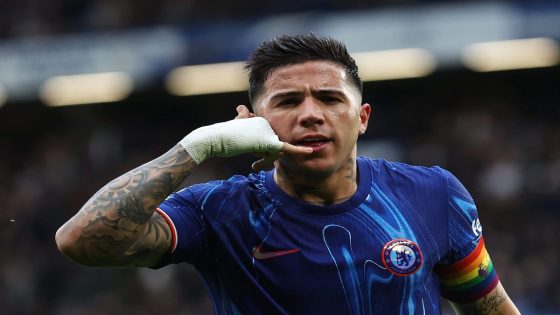It was hard to tell which moment Enzo Fernandez preferred: trapping Cole Palmer’s sharp pass and expertly lacing a low shot beyond Aston Villa goalkeeper Emiliano Martinez to double Chelsea’s lead in the 36th minute at Stamford Bridge, or standing in his own half ready for the restart around 60 seconds later, raising the arm that bore the captain’s armband to acknowledge the resounding chants of his name emanating from the Matthew Harding Stand.
For most footballers, nothing beats the feeling of scoring a goal. But that sensation is usually intertwined with the adulation that flows down from the stands in the aftermath. Fernandez had precious little taste of either in a Chelsea shirt for the best part of 10 months before pouncing on Mads Hermansen’s parry with a composed header to wrap up a 2-1 win over Leicester City at the King Power Stadium last weekend.
Now it is two goals in two Premier League starts to follow an assist for Pedro Neto’s equaliser against Arsenal last month, the kind of emphatic response that suggests he took head coach Enzo Maresca’s recent decision to bench him personally in the best possible way. He was also in the right place to set up Nicolas Jackson’s opener against the Foxes.
Signs of an individual revival went beyond the goal. Fernandez’s performance bristled with the kind of energy and positive aggression that Chelsea collectively harnessed in their pressing and passing to overpower and overwhelm Villa. “Chelsea showed that this year is different,” visiting coach Unai Emery admitted afterwards. “They are feeling stronger. They have power and (their) capacity, it is higher.”

This is more like the player Chelsea believed they were signing from Benfica in January 2023 when they agreed to meet his £106million ($135m) buyout clause as the transfer deadline loomed. Much like the £115million paid to Brighton for Moises Caicedo the following summer, that fee is and likely always will be ludicrous; a millstone hung around his neck as he has tried and failed to live up to expectations inflated to an unreasonable level.
For much of 2024 he has looked lost, derailed more by the consequences of his own decisions — banned from driving after two speeding offences in Wales; forced to apologise to his own Chelsea team-mates after live streaming an offensive chant on the Argentina team bus following their Copa America triumph in July — than by any opponent. Even the public revelations about his separation from his wife in October contributed to a sense of overwhelming negative noise.
Maresca’s controversial move to make him captain on the pitch only served to intensify the debate about his suitability, turning every appearance into a referendum of sorts. Elevating the fit-again Romeo Lavia above him for the trip to Anfield to take on Liverpool in October felt like a potentially defining moment, the first serious exploration of what a Chelsea midfield might look like absent of one of Clearlake Capital’s marquee signings.
But without Fernandez on the pitch, life became more difficult for Chelsea in the final third. Malo Gusto is simply not respected by Premier League opponents as a scorer or creator in Maresca’s right pocket, meaning Manchester United and Arsenal could focus the bulk of their defensive resources on stopping Palmer. They largely succeeded in shutting him down.

Maresca’s experimental 3-1-5-1 alignment in possession against Leicester, with Fernandez and Joao Felix operating either side of Palmer in the creative line, alleviated that problem while reintroducing the broader challenge of balancing Chelsea’s defensive structure. It never seemed viable against more dangerous opposition, but the tweaks made for Villa’s visit to Stamford Bridge absolutely do.
What do you call picking a central midfielder at full-back, then asking him to invert into central midfield? It might be more a question for Tenet director Christopher Nolan than Maresca, but Chelsea’s structure against Villa allowed the Italian to maintain the “physicality” he feels is offered by the Caicedo-Lavia axis while also enjoying the fruits of Fernandez’s goal threat and creation at the top-left corner of his midfield box. It also allows Palmer to operate in the right pocket, the area in which his own spectacular talents are maximised.
Fernandez’s best attribute is his ball progression from deeper midfield areas, but it is easy to forget what first introduced him to the wider football public at the 2022 World Cup: darting into the penalty area from a short Argentina corner kick against Mexico, faking out an opponent with a deft stepover and curling a brilliant shot into the far corner. He has a real eye for goal, and all the technique he needs to find it on a relatively regular basis.

After the Villa win, Maresca confirmed he wants to weaponise that particular skill as often as he can. “More times he was in the right positions, inside the box, and we didn’t contact with him,” he said of Fernandez in his post-match press conference. “In the action that we scored, we contacted with him.
“It is very difficult to see goals from outside the box. Almost all of the goals come from inside the box, so we need the two wingers, the two attacking midfielders and the No 9 inside the box.”
The shot from Fernandez that doubled Chelsea’s lead was unleashed from just inside the Villa penalty area, and Maresca’s point was well made. Chelsea have not had a consistent goal threat from central midfield for several years (though Conor Gallagher made strides in that direction in the second half of last season) and they will need goals from a wide range of positions and personnel if this attack is truly to take off.
It has not always been easy to determine Fernandez’s role in Maresca’s system. But with the level of focus, fitness and form he has showcased in recent weeks, he is too valuable not to include in Chelsea’s strongest side.
(Top photo: Chris Lee – Chelsea FC/Chelsea FC via Getty Images)





